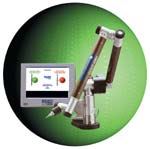On-Demand Inspection Programs
This new software takes the programming of inspection routines, and the overhead that goes with along with it, out of the shop.
Share











Checking parts in-process is viewed by most shops as non-value added time representing a necessary but cost-plus exercise. Manufacturers of gaging equipment realize that while part checking and data gathering are important activities, many of their customers would prefer to devote time, energy and resources to making parts rather than measuring parts.
The general trend in manufacturing is away from dedicated inspection departments in favor of empowering the machinist making the parts to also be responsible for the in-process inspection and data gathering for trend analysis. To that end, manufacturers of inspection and data gathering instruments have tried to create products that are shop floor and machinist friendly.
The dilemma many shops find themselves in is that the sophisticated needs of gathering data combined with more complex workpiece inspection programs are sometimes beyond the machinist’s skill level. At the same time, maintaining specialized employees dedicated to operation of inspection and data gathering instruments is expensive and counter-trend to shops trying to reduce overhead.
On complex workpieces, many of the inspection skills required to accomplish the part inspection reside with the inspection programmer. Faro Technologies, Inc. (Lake Mary, Florida) is proffering a possible alternative that allows shops to get the detailed inspection information required by increasing numbers of customers while using the machinist to obtain the data at the machine tool.
With the introduction of a new software package, which complements its line of portable inspection arms, Faro takes the programming of inspection routines, and the overhead that goes with along with it, out of the shop. The company will take a shop’s workpiece 3D CAD file or 2D print and, for a nominal fee, optimize an inspection program specifically designed for ease of use by the machinist. In effect, it’s on-demand inspection programming. Shops can participate in this service via the Internet, e-mail or overnight carrier. Turn around for this service is within 24 hours.
The new system is called Control Station, with an unabashed nod to the Sony Play Station implying its ease of use. Once an inspection program is created for a workpiece, the machinist uses the Control Station to follow a set of very basic instructions to correctly probe the workpiece. A graphic shows where to probe the workpiece, and the machinist simply points and clicks to accomplish the inspection and data collection. The company claims it’s as easy to use this system as it is to use a go no-go gage.
Once an inspection program is created by Faro, it resides in the Control Station. To revise or modify a program is a matter of sending the revised CAD file or print to Faro via the Internet, e-mail or overnight carrier. A revised program is returned within 24 hours. Moreover, for shops that have the inspection programming skills on staff, the Control Station can be programmed in-house.
Faro is presenting this inspection system as an alternative source for the relatively high skills associated with inspection routine programmers. As shops move toward more in-process gaging and data collection, Faro believes this service offers companies a cost-effective way to reduce fixed costs associated with in-house inspection and data collection.
Related Content
Ballbar Testing Benefits Low-Volume Manufacturing
Thanks to ballbar testing with a Renishaw QC20-W, the Autodesk Technology Centers now have more confidence in their machine tools.
Read MoreProcess Control — Leveraging Machine Shop Connectivity in Real Time
Renishaw Central, the company’s new end-to-end process control software, offers a new methodology for producing families of parts through actionable data.
Read MoreHow to Choose the Correct Measuring Tool for Any Application
There are many options to choose from when deciding on a dimensional measurement tool. Consider these application-based factors when selecting a measurement solution.
Read MoreTurning Fixed-Body Plug Gages Inside Out
Fixed-body mechanical plug gages provide fast, high-performance measurement for tight-tolerance holes.
Read MoreRead Next
Building Out a Foundation for Student Machinists
Autodesk and Haas have teamed up to produce an introductory course for students that covers the basics of CAD, CAM and CNC while providing them with a portfolio part.
Read More5 Rules of Thumb for Buying CNC Machine Tools
Use these tips to carefully plan your machine tool purchases and to avoid regretting your decision later.
Read MoreRegistration Now Open for the Precision Machining Technology Show (PMTS) 2025
The precision machining industry’s premier event returns to Cleveland, OH, April 1-3.
Read More
















.png;maxWidth=150)




















.jpg;maxWidth=300;quality=90)









